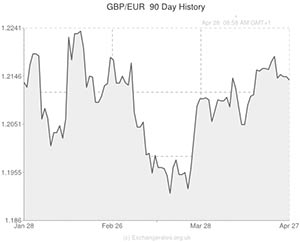
With first quarter UK GDP, Eurozone CPI inflation and US Non-farm Payrolls on the economic calendar this week there is potential for big moves in GBP to Euro and GBP to USD.
The Pound to Euro exchange rate (GBP/EUR) declined by around half a cent, from 1.2190 to 1.2140, last week as the latest Bank of England Minutes report failed to inspire traders with the belief that rates will be hiked ahead of schedule. Investors had hoped for a hawkish statement in reaction to the recent drop in Unemployment, from 7.2% to 6.9%.
However, the Minutes actually revealed that some policymakers are concerned with the high level of self-employment. The MPC discussed the possibility that the headline jobless rate could have fallen rapidly as a result of people, who would rather work full-time but haven’t been able to find a permanent position, becoming self-employed. Subsequently, some policymakers suggested that there could still be a considerable level of slack in the British labour market between current output and potential output.
The cautionary Central Bank statement also hurt the Sterling to US Dollar exchange rate, sending GBP/USD down by around a third of a cent, from 1.6830 to 1.6800.
UK First Quarter GDP
On Tuesday the Office for National Statistics is set to announce that the British economy expanded by 0.9% in the first quarter, marking a sizeable acceleration from the 0.7% growth registered in the final three months of 2013. On an annual basis it is thought that UK GDP grew by 3.2% in Q1.
If the data prints inline with economists’ forecasts then it is possible that Sterling will rally across the board as markets adjust their BoE rate hike projections. However, a softer reading could derail the Pound’s efforts to reach fresh yearly highs against the Euro and the US Dollar.
Eurozone CPI
Also on Tuesday, the latest German CPI data is predicted to show that inflation rose from 1.0% to 1.4% during April. The sturdy German figure is expected to boost the Eurozone Consumer Price Index, which is released on Wednesday and is projected to show an improvement from 0.7% to 1.0%.
Providing the CPI data meets the median market forecasts it is likely that the European Central Bank will opt to remain on the sidelines during May and subsequently demand for the single currency could increase. Under this circumstance it is possible that GBP/EUR will remain capped by resistance at the yearly high of 1.2234.
US Non-farm Payrolls
There are a number of data releases that have the potential to bolster demand for the US Dollar. Firstly, on Wednesday the US Q1 GDP report is expected to print at 1.3% and then later on that day the Federal Reserve is likely to reduce the pace of its QE3 asset purchasing programme. And finally, on Friday, the latest US Non-farm Payroll report is anticipated to show a sturdy gain of 210,000 workers during April.
The Fed decision is liable to give the ‘Greenback’ a bit of a boost, but the taper is largely priced into the market so the big moves may have to wait until Friday. If the NFP prints at 210,000 or higher then it is difficult to see the Pound maintaining itself above the current level of 1.6800.

Comments are closed.